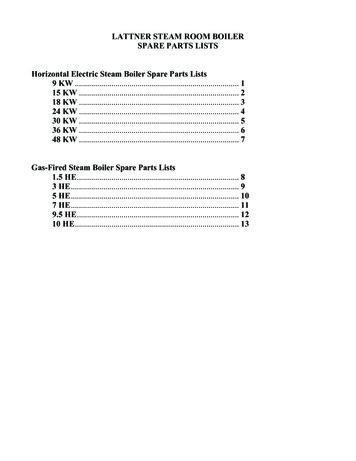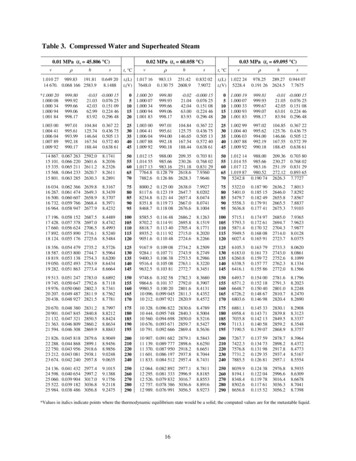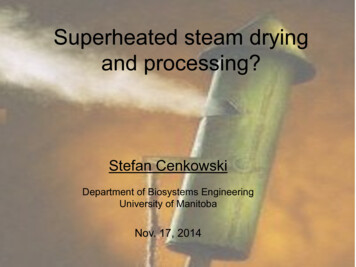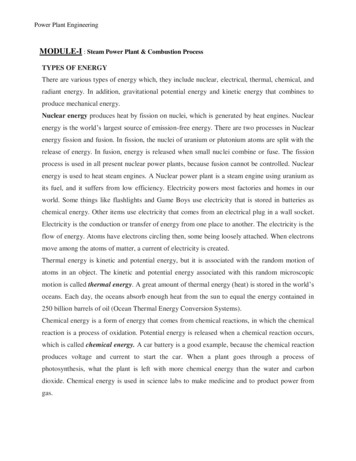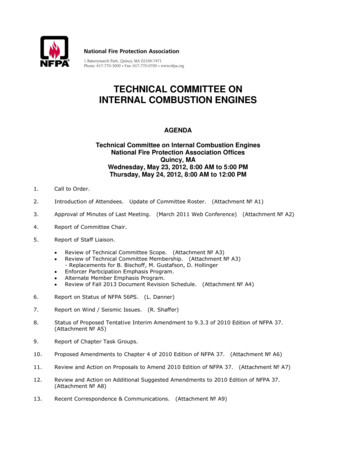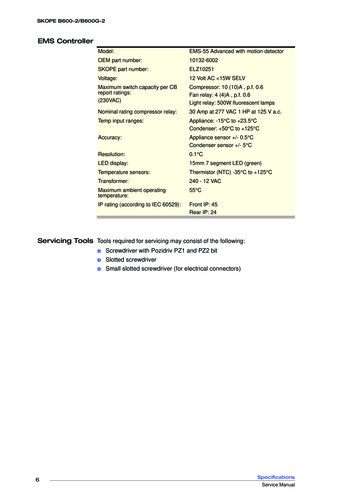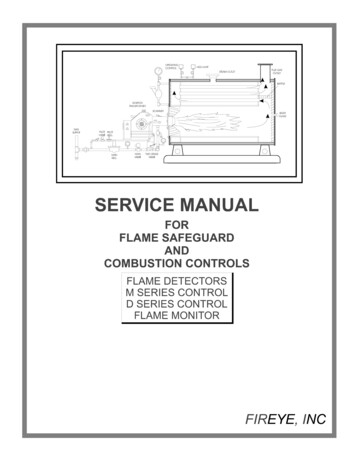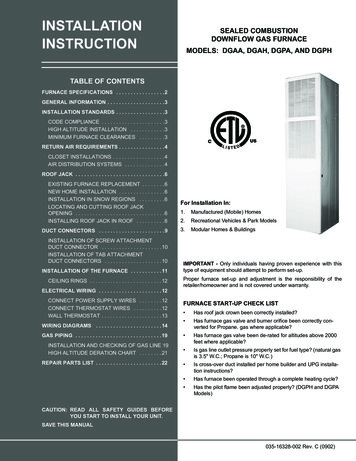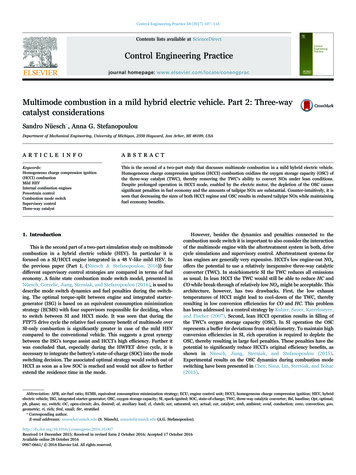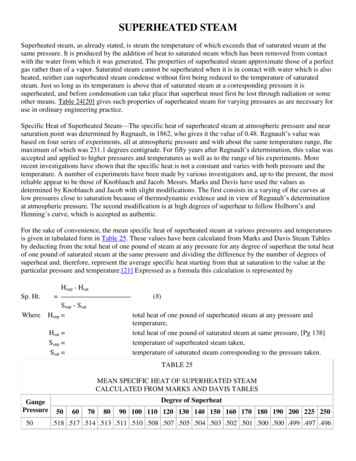
Transcription
SUPERHEATED STEAMSuperheated steam, as already stated, is steam the temperature of which exceeds that of saturated steam at thesame pressure. It is produced by the addition of heat to saturated steam which has been removed from contactwith the water from which it was generated. The properties of superheated steam approximate those of a perfectgas rather than of a vapor. Saturated steam cannot be superheated when it is in contact with water which is alsoheated, neither can superheated steam condense without first being reduced to the temperature of saturatedsteam. Just so long as its temperature is above that of saturated steam at a corresponding pressure it issuperheated, and before condensation can take place that superheat must first be lost through radiation or someother means. Table 24[20] gives such properties of superheated steam for varying pressures as are necessary foruse in ordinary engineering practice.Specific Heat of Superheated Steam—The specific heat of superheated steam at atmospheric pressure and nearsaturation point was determined by Regnault, in 1862, who gives it the value of 0.48. Regnault’s value wasbased on four series of experiments, all at atmospheric pressure and with about the same temperature range, themaximum of which was 231.1 degrees centigrade. For fifty years after Regnault’s determination, this value wasaccepted and applied to higher pressures and temperatures as well as to the range of his experiments. Morerecent investigations have shown that the specific heat is not a constant and varies with both pressure and thetemperature. A number of experiments have been made by various investigators and, up to the present, the mostreliable appear to be those of Knoblauch and Jacob. Messrs. Marks and Davis have used the values asdetermined by Knoblauch and Jacob with slight modifications. The first consists in a varying of the curves atlow pressures close to saturation because of thermodynamic evidence and in view of Regnault’s determinationat atmospheric pressure. The second modification is at high degrees of superheat to follow Holborn’s andHenning’s curve, which is accepted as authentic.For the sake of convenience, the mean specific heat of superheated steam at various pressures and temperaturesis given in tabulated form in Table 25. These values have been calculated from Marks and Davis Steam Tablesby deducting from the total heat of one pound of steam at any pressure for any degree of superheat the total heatof one pound of saturated steam at the same pressure and dividing the difference by the number of degrees ofsuperheat and, therefore, represent the average specific heat starting from that at saturation to the value at theparticular pressure and temperature.[21] Expressed as a formula this calculation is represented bySp. Ht.WhereHsup - Hsat �–––(8)Ssup - SsatHsup total heat of one pound of superheated steam at any pressure andtemperature,Hsat total heat of one pound of saturated steam at same pressure, [Pg 138]Ssup temperature of superheated steam taken,Ssat temperature of saturated steam corresponding to the pressure taken.TABLE 25MEAN SPECIFIC HEAT OF SUPERHEATED STEAMCALCULATED FROM MARKS AND DAVIS TABLESGaugePressure50Degree of Superheat5060708090 100 110 120 130 140 150 160 170 180 190 200 225 250.518 .517 .514 .513 .511 .510 .508 .507 .505 .504 .503 .502 .501 .500 .500 .499 .497 .496
60.528 .525 .523 .521 .519 .517 .515 .513 .512 .511 .509 .508 .507 .506 .504 .504 .502 .50070.536 .534 .531 .529 .527 .524 .522 .520 .518 .516 .515 .513 .512 .511 .510 .509 .506 .50480.544 .542 .539 .535 .532 .530 .528 .526 .524 .522 .520 .518 .516 .515 .514 .513 .511 .50890.553 .550 .546 .543 .539 .536 .534 .532 .529 .527 .525 .523 .521 .519 .518 .517 .514 .510100.562 .557 .553 .549 .544 .542 .539 .536 .533 .531 .529 .527 .525 .523 .522 .521 .517 .513110.570 .565 .560 .556 .552 .548 .545 .542 .539 .536 .534 .532 .529 .528 .526 .525 .520 .517120.578 .573 .567 .561 .557 .554 .550 .546 .543 .540 .537 .535 .533 .531 .529 .528 .523 .519130.586 .580 .574 .569 .564 .560 .555 .552 .548 .545 .542 .539 .537 .535 .533 .531 .527 .523140.594 .588 .581 .575 .570 .565 .561 .557 .553 .550 .547 .544 .541 .539 .536 .534 .530 .526150.604 .595 .587 .581 .576 .570 .566 .561 .557 .554 .550 .547 .544 .542 .539 .537 .533 .529160.612 .603 .596 .589 .582 .576 .571 .566 .562 .558 .554 .551 .548 .545 .543 .541 .536 .531170.620 .612 .603 .595 .588 .582 .576 .571 .566 .562 .558 .555 .552 .549 .546 .544 .538 .533180.628 .618 .610 .601 .593 .587 .581 .575 .570 .566 .561 .558 .555 .552 .549 .546 .540 .536190.638 .627 .617 .608 .599 .592 .585 .579 .574 .569 .565 .562 .558 .555 .552 .549 .543 .538200.648 .635 .624 .614 .605 .597 .590 .584 .578 .574 .569 .566 .562 .558 .555 .552 .546 .541210.656 .643 .631 .620 .611 .602 .595 .588 .583 .578 .573 .569 .565 .561 .558 .555 .549 .543220.664 .650 .637 .626 .616 .607 .600 .592 .586 .581 .577 .572 .568 .564 .561 .558 .551 .545230.672 .658 .644 .633 .622 .613 .605 .597 .591 .585 .580 .575 .572 .567 .564 .561 .554 .548240.684 .668 .653 .640 .629 .619 .610 .602 .595 .589 .584 .579 .575 .571 .567 .564 .556 .550250.692 .675 .659 .645 .633 .623 .614 .606 .599 .593 .587 .582 .577 .574 .570 .567 .559 .553Factor of Evaporation with Superheated Steam—When superheat is present in the steam during a boiler trial,where superheated steam tables are available, the formula for determining the factor of evaporation is thatalready given, (2),[22] namely,H-hFactor of evaporation ––––––––––LHere H total heat in one pound of superheated steam from the table, h and L having the same values as in (2).Where no such tables are available but the specific heat of superheat is known, the formula becomes:Factor ofevaporationWhereH h tsat T H - h Sp. Ht.(T - t) ��Ltotal heat in one pound of saturated steam at pressure existing in trial,sensible heat above 32 degrees in one pound of water at the temperature entering theboiler,temperature of saturated steam, corresponding to pressure existing,temperature of superheated steam as determined in the trial, [Pg 139]
t temperature of saturated steam corresponding to the boiler pressure,Sp. Ht. mean specific heat of superheated steam at the pressure and temperature as found inthe trial,L latent heat of one pound of saturated steam at atmospheric pressure.Advantages of the Use of Superheated Steam—In considering the saving possible by the use of superheatedsteam, it is too often assumed that there is only a saving in the prime movers, a saving which is at least partiallyoffset by an increase in the fuel consumption of the boilers generating steam. This misconception is due to thefact that the fuel consumption of the boiler is only considered in connection with a definite weight of steam. It istrue that where such a definite weight is to be superheated, an added amount of fuel must be burned. With aproperly designed superheater where the combined efficiency of the boiler and superheater will be at least ashigh as of a boiler alone, the approximate increase in coal consumption for producing a given weight of steamwill be as follows:Superheat Added Fuel Superheat Added FuelDegrees Per Cent Degrees Per Cent251.591005.69503.071508.19754.382000.58These figures represent the added fuel necessary for superheating a definite weight of steam to the number ofdegrees as given. The standard basis, however, of boiler evaporation is one of heat units and, considered fromsuch a standpoint, again providing the efficiency of the boiler and superheater is as high, as of a boiler alone,there is no additional fuel required to generate steam containing a definite number of heat units whether suchunits be due to superheat or saturation. That is, if 6 per cent more fuel is required to generate and superheat to100 degrees, a definite weight of steam, over what would be required to produce the same weight of saturatedsteam, that steam when superheated, will contain 6 per cent more heat units above the fuel water temperaturethan if saturated. This holds true if the efficiency of the boiler and superheater combined is the same as of theboiler alone. As a matter of fact, the efficiency of a boiler and superheater, where the latter is properly designedand located, will be slightly higher for the same set of furnace conditions than would the efficiency of a boilerin which no superheater were installed. A superheater, properly placed within the boiler setting in such way thatproducts of combustion for generating saturated steam are utilized as well for superheating that steam, will notin any way alter furnace conditions. With a given set of such furnace conditions for a given amount of coalburned, the fact that additional surface, whether as boiler heating or superheating surface, is placed in such amanner that the gases must sweep over it, will tend to lower the temperature of the exit gases. It is such alowering of exit gas temperatures that is the ultimate indication of added efficiency. Though the amount of thisadded efficiency is difficult to determine by test, that there is an increase is unquestionable.Where a properly designed superheater is installed in a boiler the heating surface of the boiler proper, in thegeneration of a definite number of heat units, is relieved of a portion of the work which would be required werethese heat units delivered in saturated steam. Such a superheater needs practically no attention, is not subject toa large upkeep cost or depreciation, and performs its function without in any way [Pg 140] interfering with theoperation of the boiler. Its use, therefore from the standpoint of the boiler room, results in a saving in wear andtear due to the lower ratings at which the boiler may be run, or its use will lead to the possibility of obtaining thesame number of boiler horse power from a smaller number of boilers, with the boiler heating surface doingexactly the same amount of work as if the superheaters were not installed. The saving due to the added boilerefficiency that will be obtained is obvious.Following the course of the steam in a plant, the next advantage of the use of superheated steam is the absenceof water in the steam pipes. The thermal conductivity of superheated steam, that is, its power to give up its heat
to surrounding bodies, is much lower than that of saturated steam and its heat, therefore, will not be transmittedso rapidly to the walls of the pipes as when saturated steam is flowing through the pipes. The loss of heatradiated from a steam pipe, assuming no loss in pressure, represents the equivalent condensation when the pipeis carrying saturated steam. In well-covered steam mains, the heat lost by radiation when carrying superheatedsteam is accompanied only by a reduction of the superheat which, if it be sufficiently high at the boiler, willenable a considerable amount of heat to be radiated and still deliver dry or superheated steam to the primemovers.It is in the prime movers that the advantages of the use of superheated steam are most clearly seen.In an engine, steam is admitted into a space that has been cooled by the steam exhausted during the previousstroke. The heat necessary to warm the cylinder walls from the temperature of the exhaust to that of the enteringsteam can be supplied only by the entering steam. If this steam be saturated, such an adding of heat to the wallsat the expense of the heat of the entering steam results in the condensation of a portion. This initial condensationis seldom less than from 20 to 30 per cent of the total weight of steam entering the cylinder. It is obvious that ifthe steam entering be superheated, it must be reduced to the temperature of saturated steam at the correspondingpressure before any condensation can take place. If the steam be superheated sufficiently to allow a reduction intemperature equivalent to the quantity of heat that must be imparted to the cylinder walls and still remainsuperheated, it is clear that initial condensation is avoided. For example: assume one pound of saturated steamat 200 pounds gauge pressure to enter a cylinder which has been cooled by the exhaust. Assume the initialcondensation to be 20 per cent. The latent heat of the steam is given up in condensation; hence, .20 838 167.6 B. t. u. are given up by the steam. If one pound of superheated steam enters the same cylinder, it wouldhave to be superheated to a point where its total heat is 1199 168 1367 B. t. u. or, at 200 pounds gaugepressure, superheated approximately 325 degrees if the heat given up to the cylinder walls were the same as forthe saturated steam. As superheated steam conducts heat less rapidly than saturated steam, the amount of heatimparted will be less than for the saturated steam and consequently the amount of superheat required to preventcondensation will be less than the above figure. This, of course, is the extreme case of a simple engine with therange of temperature change a maximum. As cylinders are added, the range in each is decreased and thecondensation is proportionate.The true economy of the use of superheated steam is best shown in a comparison of the “heat consumption” ofan engine. This is the number of heat units required [Pg 141] in developing one indicated horse power and themeasure of the relative performance of two engines is based on a comparison of their heat consumption as themeasure of a boiler is based on its evaporation from and at 212 degrees. The water consumption of an engine inpounds per indicated horse power is in no sense a true indication of its efficiency. The initial pressures andcorresponding temperatures may differ widely and thus make a difference in the temperature of the exhaust andhence in the temperature of the condensed steam returned to the boiler. For example: suppose a certain weightof steam at 150 pounds absolute pressure and 358 degrees be expanded to atmospheric pressure, the temperaturethen being
These values have been calculated from Marks and Davis Steam Tables by deducting from the total heat of one pound of steam at any pressure for any degree of superheat the total heat of one pound of saturated steam at the same pressure and dividing the difference by the number of degrees of superheat and, therefore, represent the average specific heat starting from that at saturation to the .

